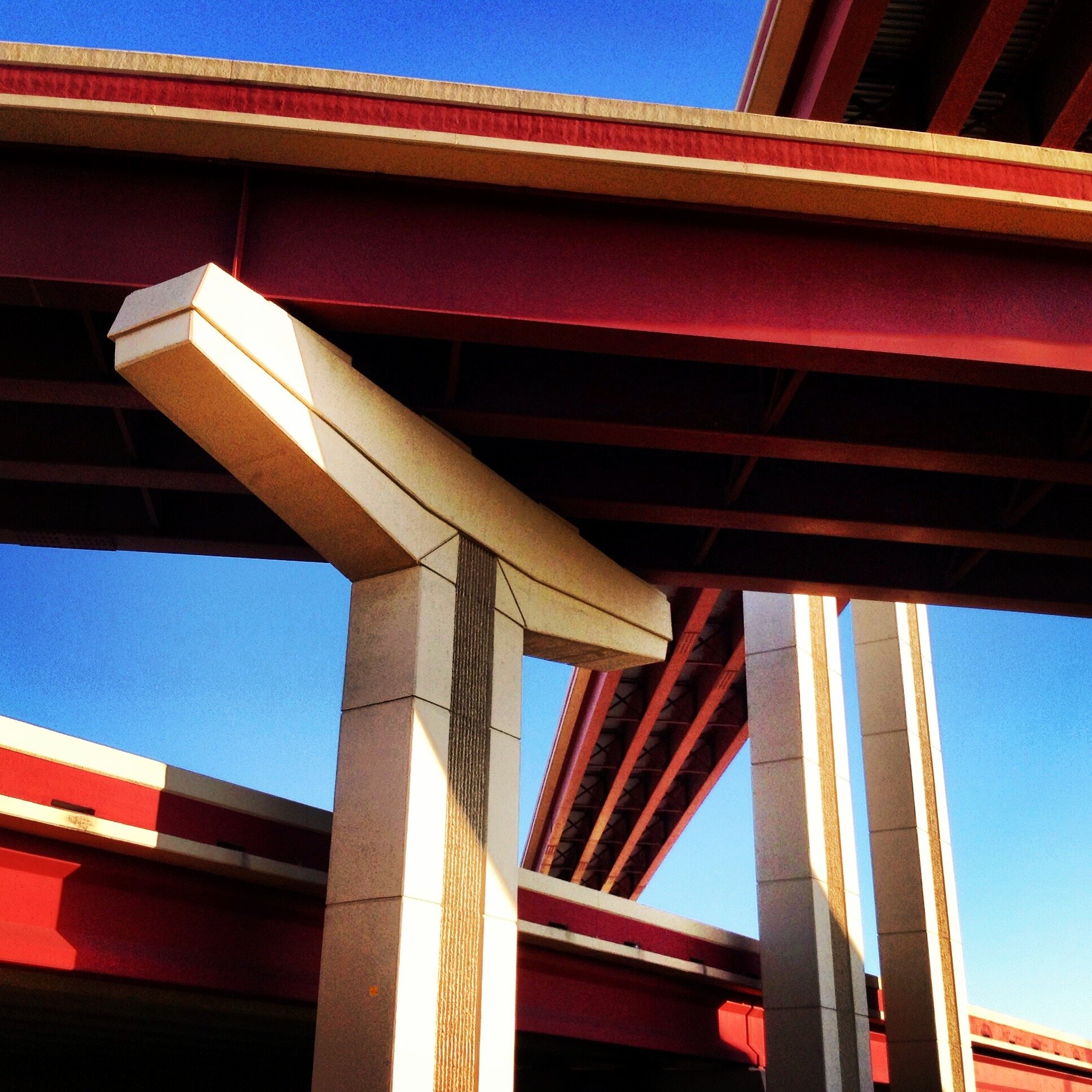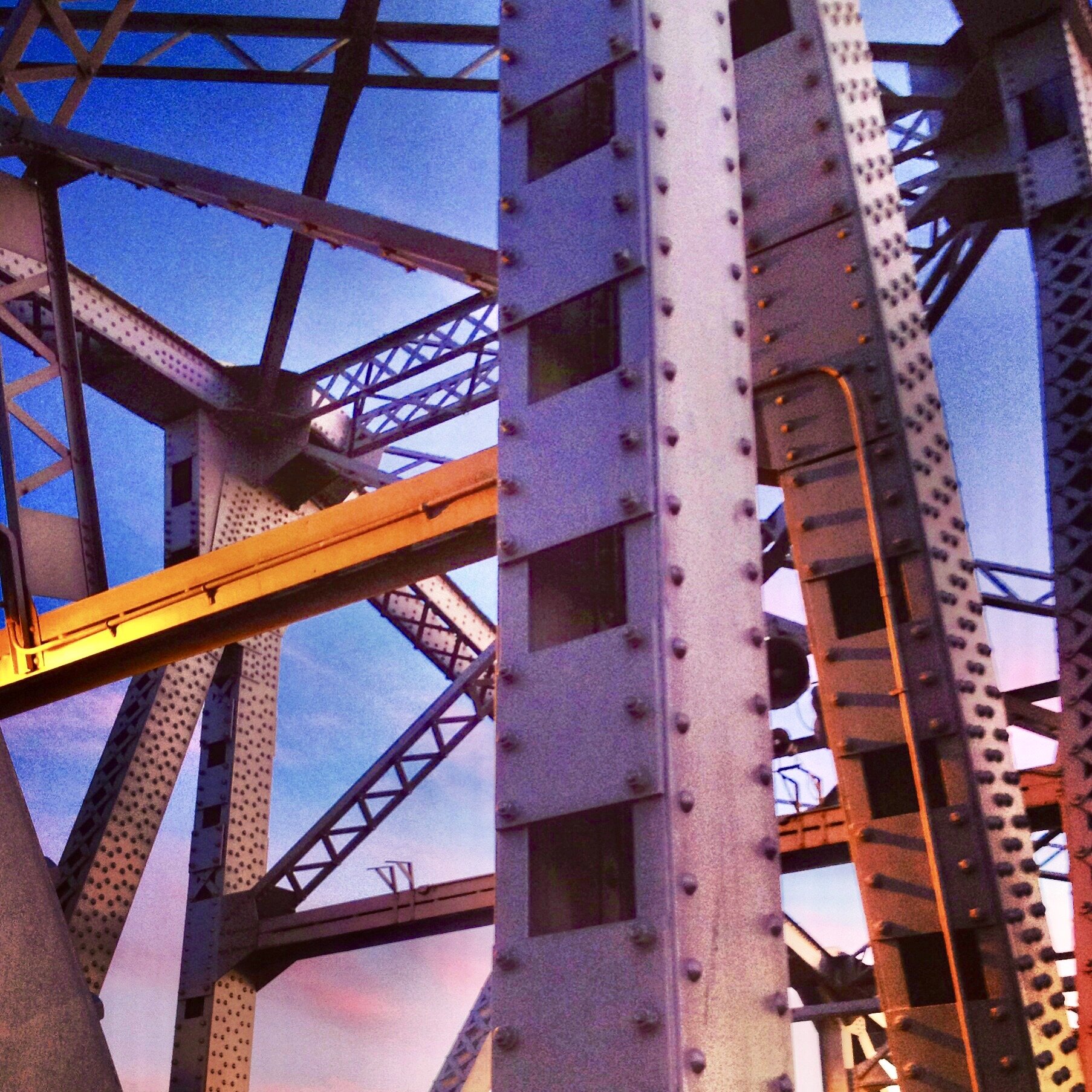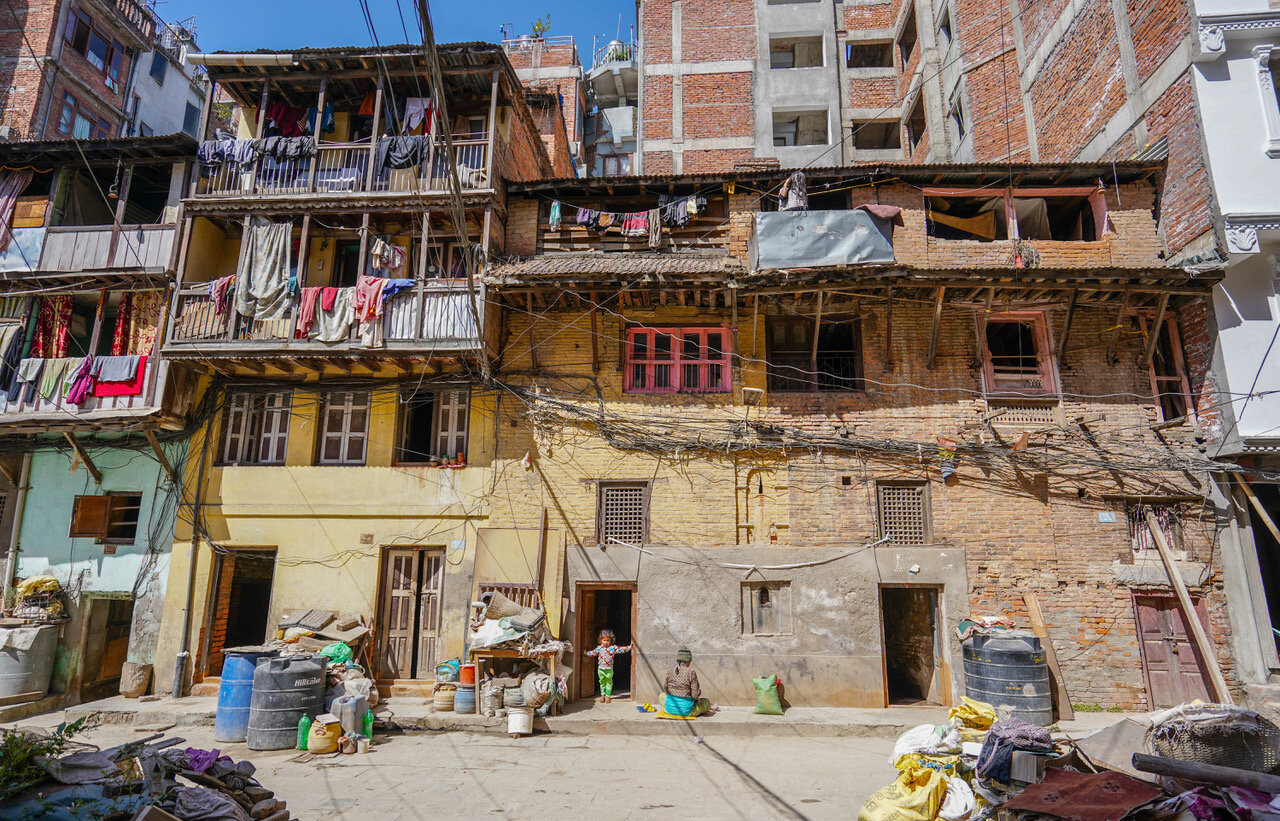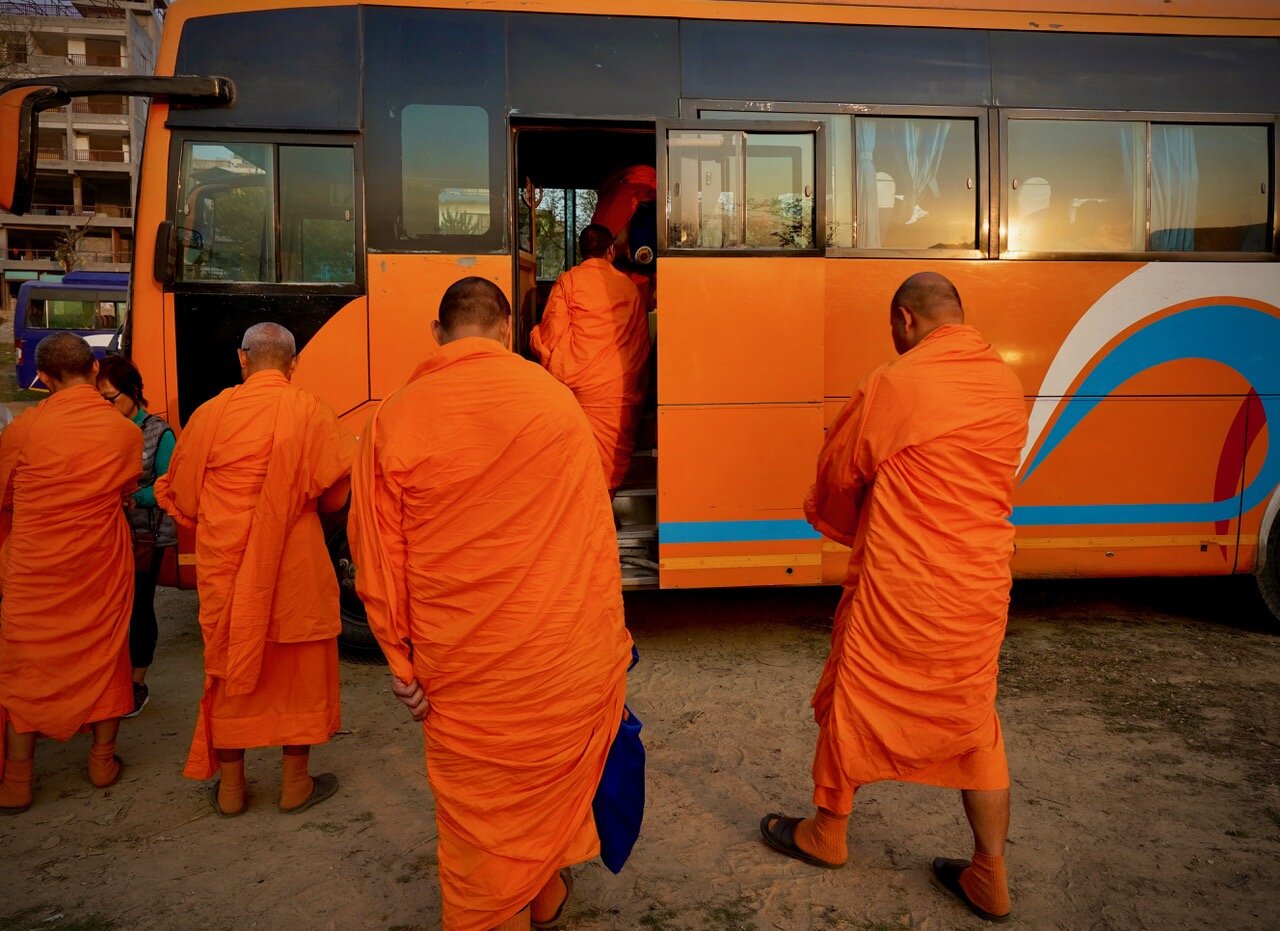FEBRUARY 2021
When I saw Marko post on Instagram that he was on-island, I tried unsuccessfully to remember when I last saw him. It had been at least 10 years.
Without thinking, I reached out, and within an hour, we had plans to meet and hike through the Haleakala Crater together. A fitting way to reunite.
Years back, we had quite a number of crater adventures together, and since meeting for beers at a bar was socially unacceptable during a pandemic, a hike through the crater was the obvious next choice.
We met at the parking lot at the top of Switchbacks, where we were both a little late. I miscalculated the timing and he missed the turnout. So, we were late together, and therefore agreed that we were on-time.
Obviously still adjusting to social-distancing, we had an awkward move toward a hug, then stopped - then a shake, and then stopped - then, we both broke out in laughter and concluded the strange dance with an air-embrace.
We got our stuff for the day situated, drove to the top of the mountain, and before long we were hiking down the Sliding Sands Trail. Descending into the crater of the volcano from the 10,000+ ft elevation at the summit, it didn’t take long before our conversation inevitably turned to art. And then, travel. And for the next 7 hours, our conversation seemed to intertwine these two subjects. Having these love affairs in common is likely why even after 10+ years of not seeing each other, it seems as if no time had passed since we last visited.
TRAVEL
One of my fondest memories of Marko, and one I still tell people to this day about, is the time when 20 years ago, I was preparing for my first trip abroad. Marko often told stories of travel - the kind recorded in books and seen on documentaries. “I landed in London with $700 and lived there for a year”, type-of-stories. So, when I was planning this big trip that would last 6 months or more, it was obvious for me to ask Marko for his input and advice.
One night soon after, we are at his house looking at a world map. I’ll never forget asking him, “Okay, so…where all have you been in the world?” He paused, without responding right away. He almost looked perplexed. Then, finally he says, “Well…let me tell you where I haven’t been - that’ll be easier!” I laughed - amazed and delighted!
I’ll never forget that.
ART
I have come to know many artists over the years, but of all of them - Marko is unique. With most artists, their art is what they do. With Marko, his life is his art. There seems to be no separation between the art and the artist.
Is this a skill that he’s developed? Or, naturally the way he is?
It’s clear that art has never been about product-making for him. Most of his artwork has been of the “street” variety - the kind that’s left behind for the world to enjoy only temporarily, until someones paints over it, or steals the left object. His art has never been about him. It’s for the world to look at, ponder, and enjoy. He’s never sought out ego-enhancing credit or acclaim. He makes the art because that’s who he is in his most his natural state.
We hiked for over 7 hours and finished just in time to watch a stunning sunset from the top of the summit. We spoke of our lives and caught up, but we largely spoke of art and of travel. Marko’s life experiences could fill the pages of several entertaining books, and a conversation like this barely scratches the surface to his many compelling stories and experiences. But, perhaps it’s enough to spark one’s imagination and inspire them to make art, and make memories.
I am thrilled to share this conversation with Saint Marko. He’s more than a longtime friend - he’s an inspiration to me. His life and stories serve as a healthy reminder to live an active and creative life, fill it with travel and exploration, and to share it with the world without looking back. And to not take any of it too seriously!
TRAVEL
SCOTT REITHER: 20 years ago, I came to you about travel advice before my first trip abroad to South East Asia. Do you remember what you told me while we looked at the World Map?
SAINT MARKO: Travel light! There's an art to minimal packing. It's not Spartan, but close. I'm sure that I recommended that before the trip you load up your backpack and walk at least a mile from your house and back. After that you'll know if you need to prioritize items and trim down your load.
I'm sure that I also shared my observation about the world being huge. The confusing reality of it is - the more you see of it, the bigger it gets.
SR: What I remember is you getting all stumped when I asked you where you’ve traveled in the world, and instead you say it’ll be easier to show me where you haven’t been. You then proceeded to point out little pockets here and there where you had yet to visit. How many countries have you been to?
SM: I've never really counted how many countries I've been to. Antartica is the only continent that has eluded me.
Shot with a plastic lens key-chain camera with flash.
Olinda, Brazil 1986
SR: What initially sparked this desire to travel? Did your family travel a lot when you were a kid? What’s your earliest memory traveling to a new place?
SM: I was a Navy brat. My dad flew anti-sub planes throughout the Circle Pacific. Hawaii was our home-base for most of my childhood. Sometimes when my father got deployment orders to the mainland US, we would go with him as a family. I remember the numerous cross-country road trips that we took throughout the 1960’s. Thousands of miles of continuous rolling landscape, framed through the windows of our car.
SR: For many years, you would spend a pretty good chunk of the year traveling abroad, is that right? And, I remember some incredible stories about shoestring budgets in your early travels. Speak about this. So often, people think they can’t travel because they don’t have the money, but I remember you telling me some crazy stories about going to places for long extended periods of time on, like $700!? How did you do it?
SM: [laughing] I still travel on a shoestring budget!
My first hard-core trip was when I was 16 and hitchhiked from the East Coast to California with my buddy Johnny Berlin. Peanut butter, water, saltines and a couple of hundred dollars held us over for most of the summer - until we were picked up by the police as runaways in Santa Cruz and sent back home to the DC area.
The $700 story was actually a $300 story. My sister was a flight attendant and gave me a Christmas present for a free round-trip ticket anywhere in the world. The fun part about it was that I had only a week to use it before it expired by the new year. Well, I took that as a challenge and quit my job, grabbed all the money I had and flew to London. After almost a year - six jobs and ten countries later - I flew back to California and got my old job back.
SR: That seems like a super-power!
So, you were doing odd jobs along the way. Did you make art along the way too?
SM: Even though I'm really good at stretching a penny, eventually you have to work. Some jobs are horrendous and other jobs are fun, but all of them get you through the lean times, and more importantly extend the length of a trip.
I’ve always made art in some form or another while on the road. Photography, graffiti, performance, rubber stamp & mail art have all worked well for journaling my experiences.
SR: I imagine you’ve had some scary moments while being out in the world alone. Does any stories come to mind?
SM: Every trip we're talking about has a scary moment. The one that comes to mind happened in La Ticla, Mexico. I had taken a three month trip with two friends south of the border for my 30th birthday. We started at the Tijuana main bus station and worked our way down the coast of Baja, and then across to mainland Mexico, surfing and camping along the way. Eventually, as each one of my buddies ran low of money, they headed back home. I managed to stay on longer living off our remaining bags of rice and beans and fishing. One early evening after finishing dinner at a local fisherman's house, I returned to my remote beach campsite and found that everything had been stolen. I was 2000 miles from home, barefoot, shirtless, and broke.
SR: [laughing] That is classic!
Does that experience even happen now with our smartphone era? Back then, you were on your own and had to work through that situation alone, using your own smarts and social skills. Have smartphones ruined travel, or enhanced it?
SM: I really appreciate the convenience of traveling with a smartphone. Not only has it greatly reduced my pack load, but it also has a readily available still and video camera. No more lugging books, cassettes or CD’s (and their players), maps, guide books, rolls of film or coins for pay phones.
I feel fortunate that I experienced all that, but you can keep that method of travel with the past. I love living in the future!
SR: If I were 2000 miles from home, barefoot, shirtless, and broke - I definitely want to have my phone!
When I get to talking about travel, I can’t help but to romanticize it so much. I think life is in many ways at its greatest when traveling to new places, without an itinerary, and not knowing what the day holds. Don’t you agree?
SM: I don't like to rush through places that I visit. I'm always afraid that I'm going to miss something to photograph or witness. Agendas and itineraries emphasize location as opposed to place.
SR: What would you say that travel has taught you above all else?
SM: No matter where you go in this world, the center of the universe is within you.
SR: Do you have a favorite place?
SM: Newfoundland Canada is one of my favorite places on the planet. It is such a unique and beautiful place with equally amazing inhabitants. In a way it’s picture-perfect.
I went up there initially twenty years ago to search out my roots - I have a personal connection there. The Barron clan left Ireland for Newfoundland sometime in the late 18th century. They settled in Newfoundland for over a century before heading to Boston about a hundred years ago. I have revisited there every year since that first visit.
SR: Hearing your stories of the place over the years definitely has made me want to come visit you. It sounds stunningly beautiful in a raw and dramatic way - the kind of compelling landscape I am most drawn to. I imagine it resembles Iceland in some ways - a place that I loved photographing. I’ll eventually get up there to see you and the land.
Marko, when someone asks you about an adventure that stands out from your many experiences, what comes to mind?
SM: Hitchhiking a cargo plane up the Brazilian Amazon river and being illegally dropped off in the middle of the runway at the Bogata International airport.
SR: [No words..]
ART
SR: You have been making artwork and expressing yourself in creative ways all the way back to a young age. I remember you telling me stories about work you were doing as a teen and putting it out into the world, right? What’s an early art memory, that set the tone for you to live a creative life?
SM: My dad gave me his camera when I was 12 and by the time I was in my early teens, I had transformed our guest bathroom into a dark room where I was able to develop film and print photos. A lot of those experimental photographs became gifts for friends and family. It was exciting to see my work in other peoples homes - sometimes framed and in prominent places. That always felt gratifying.
SR: Your parents obviously encouraged and supported you. Were they themselves creative, or artistic?
SM: My father was a Navy officer and my mother was a homemaker, but they were both very creative and often collaborated on interior design projects. My mother would create furniture that my father would construct.
Our house was always filled salon-style from floor to ceiling with paintings and objet d’art that my Mom found or my Dad picked up from his various deployments overseas.
SR: It sounds like the stage was set for a creative lifestyle from the beginning, growing up in a house like that.
COSTCO 2020
SR: A few years back, a San Diego publication wrote an article about Street Art, stating: “NO ART was confusing, blatantly illegal, and really quite brilliant. Long before Shepard Fairey’s “Obey Giant” stickers…and Banksy was still wearing knee pants…around 1978, a mysterious local artist waged a 5-year graffiti art campaign here that said it all.” The article goes on to interview YOU, the now known “No Artist”, Saint Marko. Will you speak to this some? How was this idea initially sparked, and what were you trying to accomplish with NO ART?
SM: That was the first Graffiti Art that I was doing in my early 20’s. I don’t think that the term “Street Art” was even being used yet. NO ART was a frustrated reaction to my art school college education. I had just dropped out and was venting. I tagged with a vengeance and felt vital!
SR: It’s quite flattering to think you may have inspired a young Shepard Fairey, and other artists like him. Do you think about this?
SM: Of course! But really, I've never heard of a famous artist refer to NO ART as being a form of early artistic inspiration. I have heard stories - in some cases, many years later - from friends and acquaintances from Southern California that flipped out when they found out that I was the No Artist that had inspired their scribbling on grade school Pee-Chee folders and skateboards.
SR: That must have been fun! Were you putting other artwork out into the world during this period of time, or were all your efforts toward NO ART?
SM: Well, I've been consistently photographing since I was a tween, so I’ve always had that going on while pursuing other mediums. International rubber stamp Mail Art (Home of the Brave) was something that I participated in no matter where I was living. Performance Art & Video (Bullseye, 98¢/lb, Snake eyes) is something that I have continued to explore. Also wearable statement art on T-shirts.
SR: How did the NO ART chapter end?
SM: Unfortunately, someone copied my NO ART stencil and defaced a commissioned Niki de Saint Phalle statue on a university campus. Due to the cost of the damage, the authorities were brought in to investigate, so I terminated the project. Fortunately, I was in Europe for that year and had an alibi.
SR: How do you look at “graffiti” vs. “street art” vs. “tagging”? Do you look at each of these things differently, and where does your art fall in the categories?
SM: I refer to all of my outside pieces as Street Art. Whether it is self-historified bronze plaques, alternate street signs, landscape painted abandoned cars, or a huge Balinese shadow-puppet-inspired Bigfoot installation along the Trans-Canada Highway. It all falls under “Department of Beautification”.
SR: What is the Department of Beautification? What are a few examples of what the Department has done?
SM: The DOB is a fun, quasi-official looking department of beauty, complete with a utilitarian uniform and emblem. The subjectivity of beauty, combined with the objective departmental appearance, is designed to confuse and entertain. I have already mentioned some of the projects, so what should also be noted is - I often ask for group participation. I have official uniforms of all sizes with a unique emblem. As an outside viewer, you think it is an official group working in a public space. For the last 30 years, most of my ongoing projects have fallen under the umbrella of the Department of Beautification.
MOWING THE GRASSY KNOLL, DALLAS, TX - PERFORMANCE ART FOR THE 50TH ANNIVERSARY OF THE KENNEDY ASSASSINATION - DEPT. OF BEAUTIFICATION | PHOTO BY DAVED MARSH
SR: There’s this idea that nothing is original, and everything is a remix of what has come before us. Even Picasso famously said, “Good artists copy, great artists steal.” What are your thoughts on this? Are there artists that clearly influenced your ideas and what you have done - and if so, who are they? Is your objective to make “original” art, or to express something personal?
SM: I've owned and studied photo books and magazines since I was a kid so there's no way that they did not have an influence on me. Walker Evans, Minor White, Robert Frank, Imogene Cunningham, Paul Strand, Man Ray, Weegee and Henri Cartier-Bresson were among my early visual guides.
In my view, we are all artists. We are all unique and original individuals. Nothing is instinctual and everything is learned. Therefore all art is personal yet not necessarily original.
SR: Is it even possible to do totally “original” art that has not been done before? Do any artists come to mind on this topic?
SM: The work of Marcel Duchamp, Banksy, Anselm Kiefer, Joseph Beuys, John Baldessari and any Outsider artists seem completely original to me.
SR: When visitors to your Instagram account browse around, they will see an ongoing series of covered cars. A bunch of ‘em! What’s the story behind this?
SM: One of the earliest photo books that I've ever owned, besides the Time/Life series on photography, was Robert Frank’s The Americans. In it is a memorable photograph taken in Long Beach of a dramatically lit covered car with two date palms on either side of it. That image left a lasting impression on me with its harsh lighting, street angle, shrouded car and looming trees. Over the years, when I’ve noticed covered cars, I’ve taken pictures of them in homage to that image.
When I moved to Alameda, California in 2013, I noticed an unusual amount of covered cars and started taking daily pictures of them with my iPhone and posting them on IG. Interestingly, over the years the photos have included more of the surrounding architecture and landscape and less of the covered car.
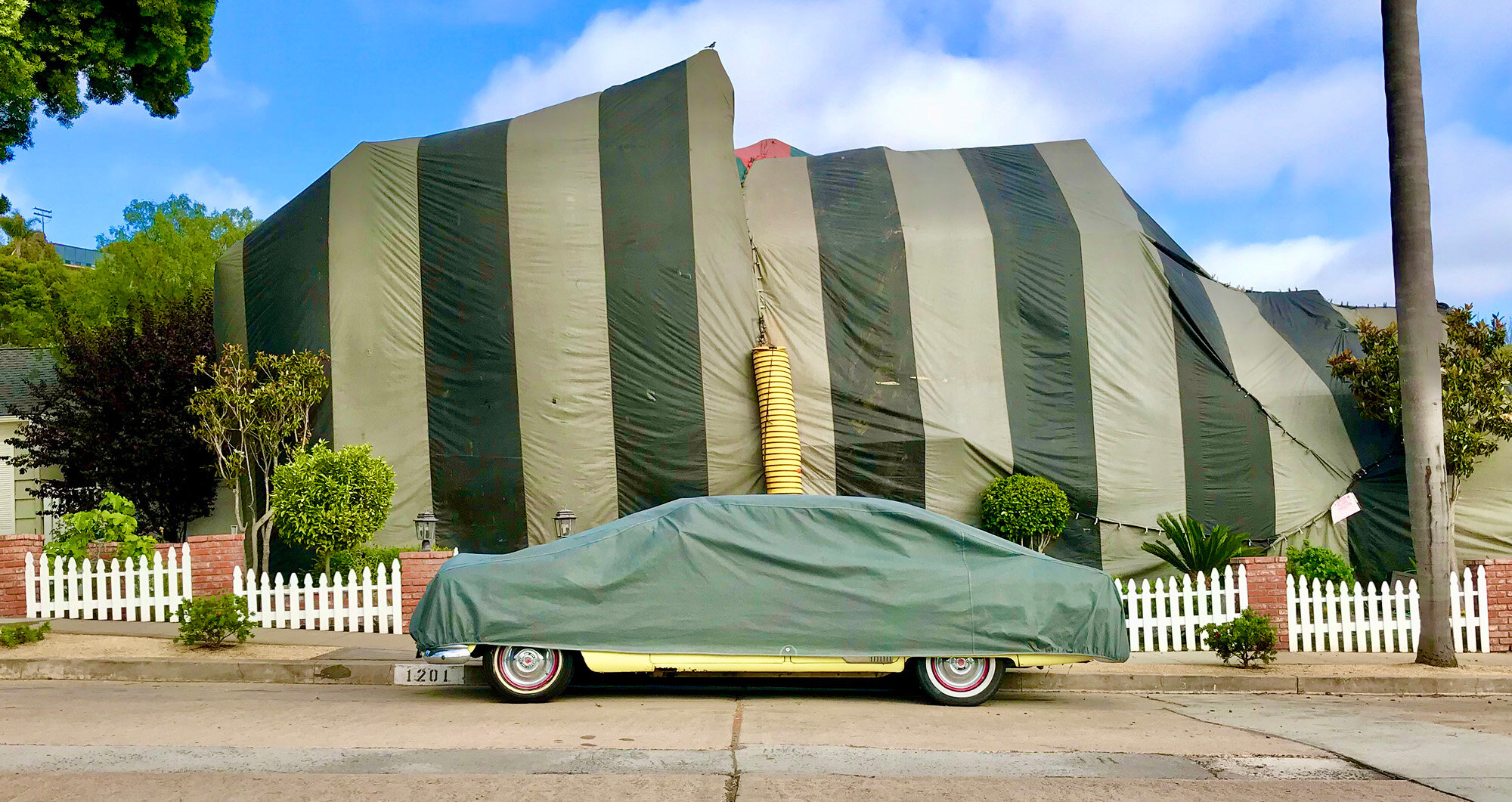
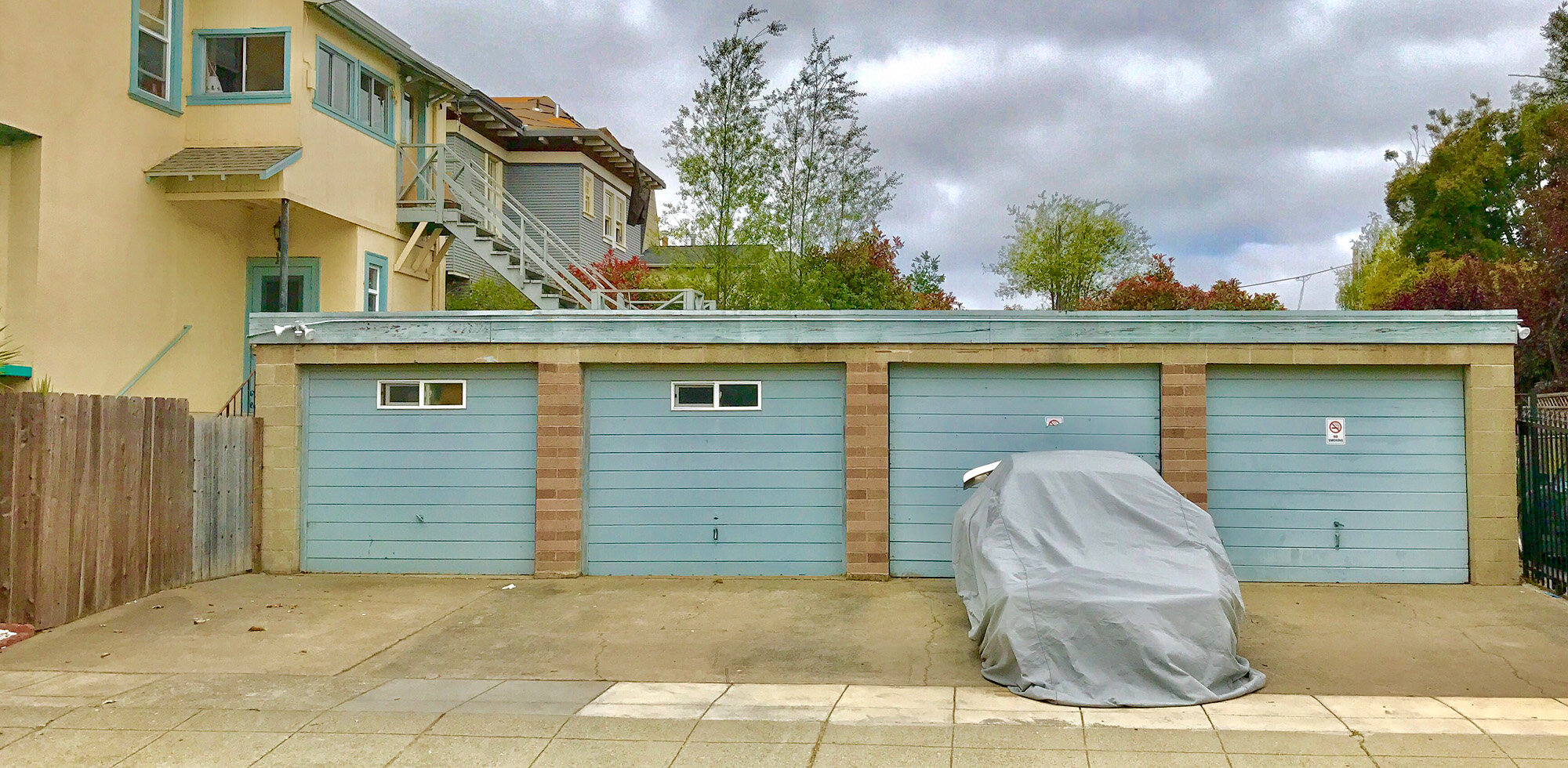

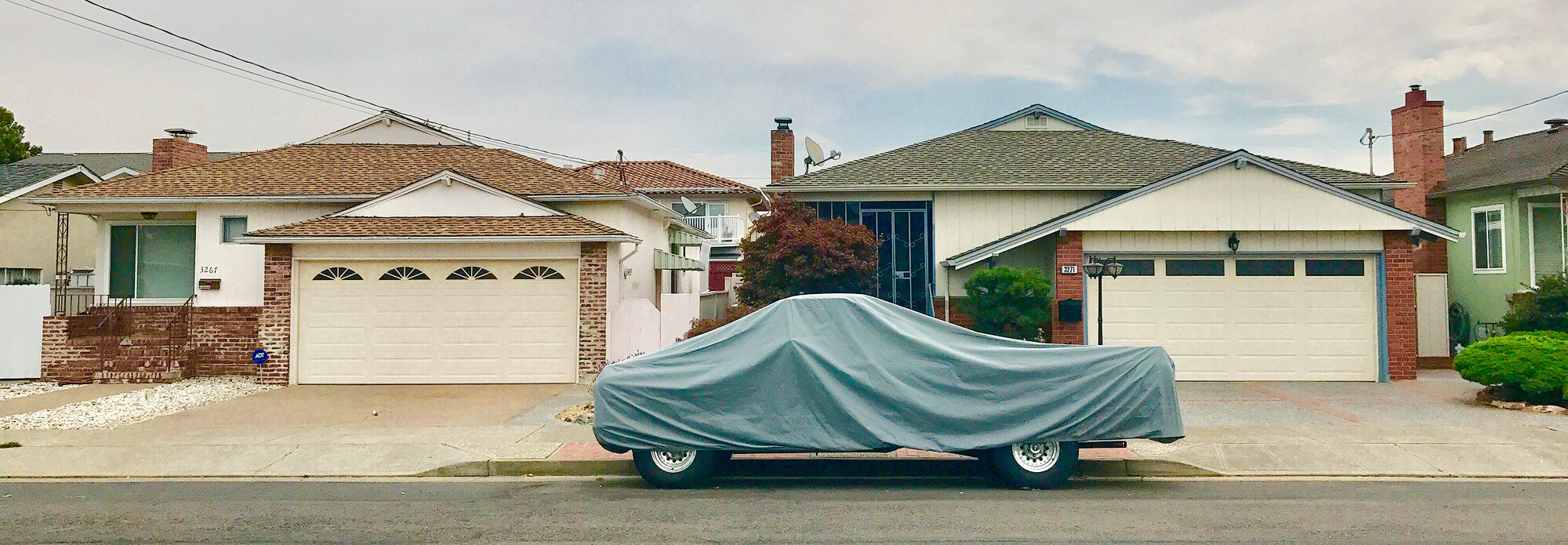
SR: Your photos on Instagram are often very creatively captured elements of the mundane of day-to-day life. Do you have that “photographer’s eye” always actively looking for interesting elements, or are these simply things that capture your attention? I guess what I’m asking is - do you actively seek these pictures out?
SM: Everything that I post on IG is shot with my phone. Since I always have my phone with me, I’m a bit more relaxed in searching for potential shots and the results are more experimental than when I use my proper camera. I do know that I am constantly looking for ironic and abstract looking situations to photograph where ever I go.
I'm kind of a low-tech photographer and prefer to use the camera off my phone. In fact I got an undergraduate degree in photography using mostly plastic lens cameras. I don’t mind the low-res look.
SR: When I think of your art over the years, in addition to the covered cars and NO ART, I think of your signs, and your t-shirts. Can you share some of your more successful signs and t-shirts and speak a bit on them? What sparked their creation? Where were they erected/who was the audience?
SM: Probably the most successful sign I ever posted was the one that saved lives.
WHALE WATCHING IS NOT AN EMERGENCY
KEEP DRIVING
...was a sign that I made and placed below an existing sign that read EMERGENCY PARKING ONLY. Every year on Maui, tourist jaywalkers are hit and killed from illegally parking their cars halfway on the dangerously curvy Pali (cliff) highway, and then darting into traffic in order to see the winter migrating whales. That year, the number of traffic fatalities at that location dropped dramatically.
I’ve probably created close to a hundred t-shirts over the years. I like self-reflecting small-print shirts with the message on the upper back center, designed for when people are walking behind you or when waiting in line. One of my latest t-shirts read: HAVE YOU BORED SOMEONE WITH A SELFIE TODAY?
SR: I’m gonna steal a question that Tim Ferris asks - if you had a billboard that a billion people would ultimately see, what would you put on that billboard?
SM: Definitely not words, since 1 billion people worldwide means that some readers will be illiterate and others may not understand your language. It would have to be a pattern, color or an image. Probably, I’d put one of my more curious photographs up there so that a billion people would be asking each other who put that up there and why!
SR: How would you define “Art”? And, what makes an “Artist”?
SM: Everyone's an artist and everything is art. Setting up exclusionary rules only bites you in the ass further down the road when the tides of taste eventually turn.
SR: Is an audience important?
SM: Certainly not in the art making process! That should be pure and not muddied by the expectations of a potential critic or consumer. Unfortunately, rainbows and dolphins sell - so if your audience needs to be controlling, simply include a token kitten in your image. A glib, yet somewhat truthful statement.
SR: When I look over my 20 year creative path as a photographer, so much of what I do has been directly connected with a viewer, client, or collector. Early on, I am sure that some of this was for ego-enhancing benefits. But, I don’t think that’s any longer the case for me. I don’t do this work to fuel my ego. If anything, I live a creative life to lessen my ego and my identification to it. With that said, sharing and interacting with the “viewer” still holds value for me and largely fuels and inspires me to keep moving forward.
Much of what you have done is with no fanfare. No feedback. Anonymous. In many cases - like with NO ART - viewers of the work didn’t even know who the artist was until decades later! Can you speak to this? What drives you to do the art?
In short - Why make art?
SM: Wow, well said and a great question. I'm hopeful in imagining that somewhere, someone is actively thinking about something I’ve created, but it’s not important who they are or really who I am. What’s cathartic for me is to relinquish the burden of an idea through art.
SR: If you could go back in time and speak with your 20 year old self, knowing what you know now, what would you tell yourself?
SM: Well that would've been 1975 in San Diego, so I would have told myself to drive straight to Albuquerque, New Mexico and find the garage of Bill Gates. Then give him all of my money to invest in his fledgling Microsoft project, then drive back home and start saving all over again for my planned trip for two to Europe. Then, really piss off my girlfriend when I do the same thing the next year - up in the Palo Alto garage of Steve Jobs! That’s teaching the fine art of investing.
Oh, and take lots of pictures along the way.
Be sure to Follow Saint Marko on Instagram:
And let him know you enjoyed this conversation!
Speaking on behalf of all the many people who have enjoyed your artworks and never had the opportunity to tell you directly - Thank you so much Saint Marko! The world is served well by expressive and creative people openly sharing their works of art, just for the sake of the work and the process alone. You have inspired many and continue to do so with each creative project you put out into the world - it has not gone unnoticed!
Thank you for sharing with my audience here. It is greatly appreciated.





